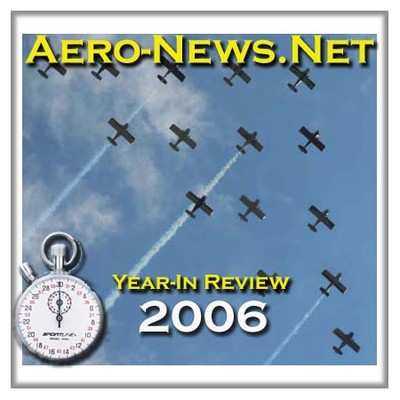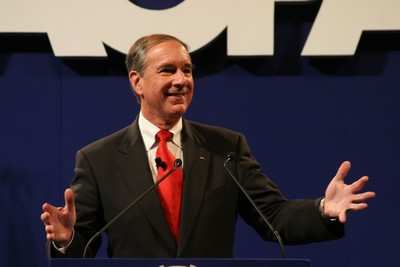ANN Salutes Those Who Did The Most For Aviation And
Aerospace
It is both the most "fun," and most difficult task, facing the
ANN staff at the end of every year -- determining who, or what, did
the most to promote the cause of aviation in the past 365 days...
while also chastizing those who did all they could to undermine the
many successes the aerospace community has managed to
accomplish.

Thankfully, 2006 was a year in which we saw the best and
brightest among us step forward and work tirelessly on behalf of us
all. No doubt about it... the challenges we faced in 2006 were
numerous, and ongoing... so was the quality of expertise and
passion brought to our defense by those who heroically demonstrated
to the the world the very best side of aviation... via their deeds,
words and actions.
It is ANN's honor to recognize the first three of our
Aero-Heroes of 2006. Thank you, folks... we really needed you this
year, and you didn't let us down.
"THE Guys" -- Ed Bolen, Phil Boyer, Tom Poberezny
With every passing year, general and business aviation comes
under attack by legislators and the media with greater urgency,
ever-louder (and completely bogus) allegations of inflated threat
risks, the erstwhile battle with the FAA and the airlines over user
fees... and staggeringly mediocre coverage of GA's role in aid and
rescue efforts.
_tn.JPG)
2006 saw FAR more than its share of all these events... which is
why ANN is once again comforted to know that we pilots have some
VERY heavy hitters (pictured above and below, alphabetically) in
our corner, fighting against these efforts.
This year, especially, showed us the power of what a united
front can do. Efforts by Ed Bolen, CEO of the National Business
Aviation Association; Aircraft Owners and Pilots Association
president Phil Boyer; and EAA president Tom Poberezny, in
particular, tirelessly worked to promote the importance of general
aviation to the entire country -- while also standing strong
against relentless attacks from the general media, and those
looking to saddle GA with higher fees to benefit the airlines.

All three are repeat honorees in this category -- a sign of both
the continued importance of their respective organizations, as well
as the constant struggles facing general aviation. (We wonder if
all three wouldn't appreciate a year where they WEREN'T recognized
as such, as that would mean far calmer skies for GA.) This year,
however, added a new wrinkle... as Bolen, Boyer and Poberezny --
all representing different interests within the ever-widening
umbrella over GA -- joined forces against the threat of user fees,
and media attacks on GA safety and security.
In particular, Bolen and Boyer made it clear to the FAA early
on, that trying to pit private and recreational pilots against
their "bigwig" counterparts in the business aviation community in
the fight over user fees wouldn't be successful. Poberezny joined
in this fight, as well, to represent the homebuilder and
experimental pilot community. All three recognized what affects any
one of them, affects ALL of them... and if it doesn't now, you can
bet your Glasair it will down the road (as Boyer put it... "beware
the camel's nose.")

We COULD have recognized only one of these guys, and justifiably
so; it's far more gratifying, however, to recognize all three --
for just as the Allied nations battled the Axis in WWII, these guys
are all fighting for the greater good of general aviation. While
they approach those same battles from different angles -- and don't
always agree on some issues -- all three have allied against common
foes, and shown a great degree of class in doing so.
The war is far from over -- but the guys on the frontlines are
doing their jobs, giving us the 110% we so desperately need -- so
without a shred of doubt, they deserve our thanks.
Cirrus Owners and Pilots Association (COPA)
 Anyone can ask why
small aircraft continue to go down -- even as planes continue to be
safer, and training protocols and safety equipment are more
advanced and widely available than ever. But the Cirrus Owners and
Pilots Association is working to find solutions to benefit its
burgeoning membership... and all pilots.
Anyone can ask why
small aircraft continue to go down -- even as planes continue to be
safer, and training protocols and safety equipment are more
advanced and widely available than ever. But the Cirrus Owners and
Pilots Association is working to find solutions to benefit its
burgeoning membership... and all pilots.
Aero-News was HIGHLY impressed with what we saw during COPA's
annual meeting, which coincided with AOPA Expo 2006. The gathering
was alternately great fun... any event that starts off by launching
a remote control helicopter from a cake earns points with us... and
deadly serious. The meeting was held one month after the
high-profile crash of an SR20 into a Manhattan highrise... and
that, combined with other accidents involving Cirrus planes in
2006, clearly had the membership somewhat rattled.
But COPA doesn't merely pay lip service to the issue: it offers
its membership several outstanding programs and seminars, all to
propagate what the group calls a "safety culture" throughout its
pilots.
What is a safety culture? It's an aviation way of life; where
safety is paramount not only in word, but also in deed.
For starters, there is the Cirrus Pilot Proficiency Program -- a
two-part, ground and flight training program all members are
encouraged to attend annually. Subjects discussed include normal
and emergency procedures, weather, advanced avionics, maintenance
and single-pilot resource management. The flight portion is nothing
short of an intense biennial flight review -- you know, the kind
your local FAA flight examiner might give.
Just as a smart pilot always reviews his performance and looks
for ways to improve, COPA as an organization isn't shy about
pointing out its own flaws. This one observation should tell you a
great deal about the association.

COPA also hosts a Cirrus-sponsored seminar on Critical
Decision-Making (CDM). COPA members attending the CDM seminar
participate in discussions on key safety topics. Cirrus factory
pilots maintain a higher than average safety record and they share
their observations and techniques with attendees. Also of note to
COPA is the difference between currency and proficiency. Seminar
leaders help attendees understand how to evaluate their own
proficiency and factor it in decisions relating to personal
minimums.
Cirrus Design co-founder Alan Klapmeier believes so strongly in
the CDM program, the company makes them free to attend -- all you
have to do is get yourself there.

COPA also publishes a document it calls a "Code of Conduct." If
one document could embody the COPA safety culture, this would be
it. In COPA's own words, the Code provides a set of guidelines
helping pilots improve their airmanship, flight safety, and to
sustain and improve GA. The Code presents a vision of excellence in
GA. Its principles both complement, and supplement, what is merely
legal.
COPA makes this "Code of Conduct" available for free download on
its website, as it should not apply only to Cirrus jockeys. Pilots
should laminate this code, and stick it on their lapboards
immediately... and reread it at EVERY opportunity.
We are heartened, and excited, by the attitude we see among COPA
membership. When a member of COPA tells you safety is THE
overriding concern for ALL of his or her flights, you can be sure
you're not just receiving lip service -- you're speaking to a
believer.
It would behoove other pilot groups -- and manufacturers -- to
adopt similar attitudes, and quickly. It may just save lives.
The Unsung Masses At NASA
 No doubt about it: 2006 was a
banner year for the National Aeronautics and Space Administration.
The number of successes the space agency enjoyed in 2006 was
unprecedented, and far too numerous to mention here (We go into
more detail elsewhere.) NASA Administrator Michael Griffin also
seems to be coming into his own as the agency's head, and chief
public figure -- publicly, and convincingly, defending President
Bush's plan to return to the moon.
No doubt about it: 2006 was a
banner year for the National Aeronautics and Space Administration.
The number of successes the space agency enjoyed in 2006 was
unprecedented, and far too numerous to mention here (We go into
more detail elsewhere.) NASA Administrator Michael Griffin also
seems to be coming into his own as the agency's head, and chief
public figure -- publicly, and convincingly, defending President
Bush's plan to return to the moon.
While we may not always agree with where NASA's agenda is
heading, and how it intends to get there... NASA has certainly
earned kudos in 2006. But no one person at the space agency
deserves more credit for NASA's string of successes, than the
untold numbers of scientists, engineers, and workers who seldom (if
at all) receive public acknowledgement for their roles in exploring
space.
We're speaking of the scientists who labored over the precise
calculations that brought the Stardust space probe back to Earth
safely, and with a wealth of data; the engineers who returned the
shuttles Discovery and Atlantis to flight this year, and came up
with the kind of quick thinking, on-the-fly solutions to vexing
problems we haven't seen since the Apollo 13 mission.
We're talking of the unsung workers behind the scenes... each
with a significant duty to perform, in a business where the
slightest single error can spell disaster for both man and
machine.
We dare you to watch a shuttle launch, or the ascent of a new
space probe to the heavens, without feeling a lump in your throat,
or chanting "go, baby, go" under your breath. While you may not
think about it at the time... these workers are right beside you in
spirit. And they all have a stake in each success, or failure.

In Pulitzer Prize-winning author Studs Terkel's book "Working,"
the reader sees a person's fundamental need to be able to point at
something that displays their accomplishments... while also keeping
sight of their dreams, even as fate may conspire to keep those
dreams distant. For employees at NASA, those two disparate needs
are one in the same... but with the added onus if the job
isn't done correctly, those dreams can very quickly become
nightmares.
We saw a lot of dreams come true in 2006.
Good job, guys.
Coming Sunday... ANN's First Three Heartbreakers Of
2006
 ANN's Daily Aero-Linx (04.15.24)
ANN's Daily Aero-Linx (04.15.24) Classic Aero-TV: 'No Other Options' -- The Israeli Air Force's Danny Shapira
Classic Aero-TV: 'No Other Options' -- The Israeli Air Force's Danny Shapira Aero-News: Quote of the Day (04.15.24)
Aero-News: Quote of the Day (04.15.24) Airborne 04.16.24: RV Update, Affordable Flying Expo, Diamond Lil
Airborne 04.16.24: RV Update, Affordable Flying Expo, Diamond Lil ANN's Daily Aero-Term (04.16.24): Chart Supplement US
ANN's Daily Aero-Term (04.16.24): Chart Supplement US

_tn.JPG)









